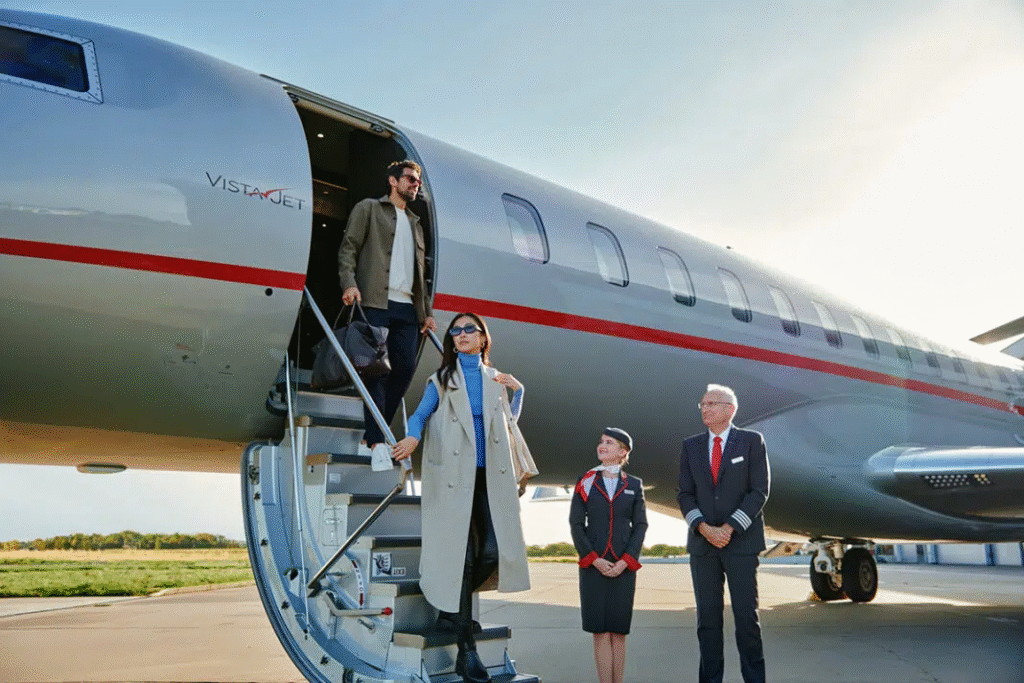In the rarefied world of private aviation, where exclusivity and comfort meet altitude and luxury, a new standard of indulgence is quietly taking shape—one that has nothing to do with speed or seating, but with flavor. Gone are the days when in-flight meals were limited to reheated dishes and uninspired plating. Today, private jet travelers are savoring Michelin-level cuisine thousands of feet above the clouds, thanks to a new generation of private jet chefs who are redefining what gourmet dining truly means.

The New Face of Sky Dining
It’s no longer enough for private jet experiences to simply offer leather seats and vintage champagne. The modern luxury traveler expects personalization, and that extends deeply into their dining experience. This shift has given rise to a trend that home style magazine describes as “the next evolution of luxury travel dining.”
Private jet chefs are not just cooks—they are curators of taste, crafting dishes that reflect the client’s personality, mood, and destination. Whether it’s a truffle-infused risotto for a business mogul en route to Milan or a plant-based Mediterranean platter for an influencer flying to Santorini, every meal is made-to-order, fresh, and inspired.
But how exactly do these culinary artists manage to maintain Michelin-star quality at 40,000 feet, where air pressure dulls flavor and space is limited? The answer lies in innovation, adaptability, and a touch of creative rebellion.
Crafting Flavor at Altitude
Cooking on a private jet is an entirely different challenge than cooking in a restaurant kitchen. The altitude changes everything—from how food tastes to how it’s prepared. Airplane cabins have lower humidity and air pressure, which can dull taste buds by nearly 30%. That means chefs must balance flavors with precision, amplifying herbs, acidity, and seasoning to ensure every bite feels rich and complete.
Some chefs prepare elaborate base components on the ground, using sous-vide techniques or flash-freezing to preserve texture. Others prefer to plate and garnish in-flight, ensuring that presentation and aroma remain impeccable.
As highlighted by private aviation magazine, many private jet chefs now work closely with nutritionists, sommeliers, and local ingredient suppliers to create menus that are both luxurious and balanced. Organic produce, premium cuts of meat, and rare spices are often flown in directly from their source—yes, even if it means fresh Japanese Wagyu beef or Peruvian cacao being loaded onto a flight from London to Dubai.
From Ground to Sky: The Journey of Ingredients
Behind every private jet meal is a fascinating logistical ballet. Ingredients are sourced with the same attention to detail as a five-star restaurant’s supply chain. Every element—down to the microgreens and sea salt—is chosen for freshness, quality, and sustainability.
Some private jet operators have even partnered with farm-to-table suppliers to ensure ethical sourcing. Others maintain exclusive relationships with luxury brands—think caviar from the Caspian Sea or handcrafted chocolate from Switzerland.
Chefs often meet with clients before a flight to discuss preferences. Do they crave comfort food that reminds them of home, or a culinary adventure reflecting their next destination? As one celebrated private jet chef told private aviation magazine, “We’re not just feeding travelers; we’re designing moments they’ll remember.”
Personalized Menus: Where Taste Meets Identity
Every menu on a private jet is a reflection of its passengers. Unlike commercial first-class dining—which offers a few pre-set options—private jet chefs craft unique menus for each journey.
A wellness-conscious traveler might request gluten-free or keto dishes prepared with organic ingredients. A family celebrating a special occasion might have a seven-course tasting menu paired with rare wines. For business leaders, power breakfasts are often designed to enhance alertness, featuring brain-boosting ingredients like avocado, salmon, and nuts.
This level of personalization goes far beyond luxury—it’s an emotional connection between passenger and plate. It’s the reason why home style magazine calls this “the most intimate form of in-flight luxury ever created.”
Technology and Precision: The Tools of the Trade
While the kitchen on a private jet is small, it’s astonishingly efficient. Compact induction cooktops, sous-vide equipment, precision ovens, and vacuum-sealed storage systems allow chefs to replicate fine-dining techniques midair.
Some aircrafts are even customized to include mini gourmet kitchens, complete with wine coolers and spice drawers. This technological evolution enables chefs to maintain consistency and creativity without compromise.
But beyond the tools, it’s the artistry that matters most. Every element—texture, temperature, timing—is orchestrated to perfection. A delay in plating or slight miscalculation in seasoning can change the entire sensory experience. That’s why many private jet chefs undergo specialized aviation culinary training to understand the science of cooking at altitude.
The Global Palate: Culinary Cultures in the Clouds
Private jet dining has also become a platform for global gastronomy. Passengers are no longer bound by location—they can enjoy French cuisine while flying over the Sahara, or authentic Japanese omakase en route to New York.
This fusion of cultures reflects a broader trend in luxury travel—one where boundaries blur and experiences blend. As private aviation magazine notes, “Every flight becomes a culinary journey that transcends geography.”
Chefs frequently draw inspiration from destinations on the itinerary. Flying to Paris? Expect airy soufflés and aged Bordeaux. Landing in Bangkok? Think lemongrass, chili, and coconut aromas filling the cabin. This dynamic creativity keeps dining at 40,000 feet both surprising and deeply personal.
Final Thoughts
Culinary excellence has found its newest and highest home—aboard private jets. With innovation in technique, devotion to detail, and a global palette of inspiration, private jet chefs are transforming travel itself into an epicurean adventure.
The next time you step onto a private jet, remember: you’re not just crossing time zones—you’re tasting the evolution of luxury dining in motion.
As home style magazine so elegantly put it, “True luxury is not in the destination—it’s in the flavor of the journey.”


